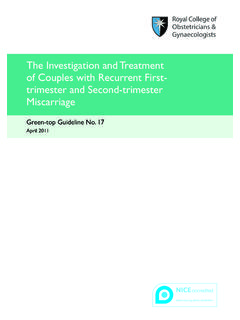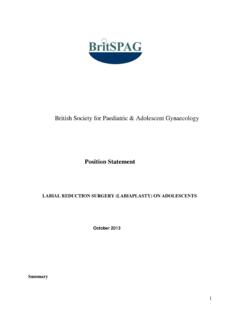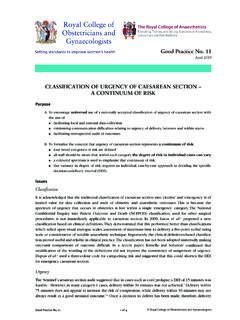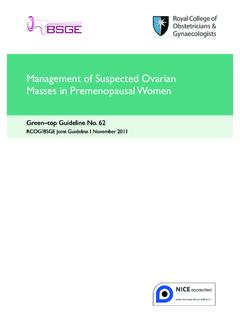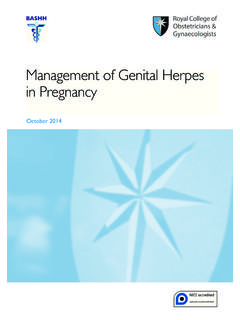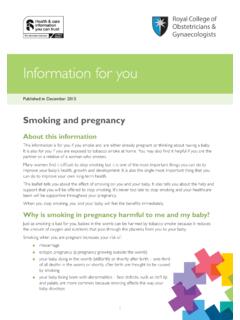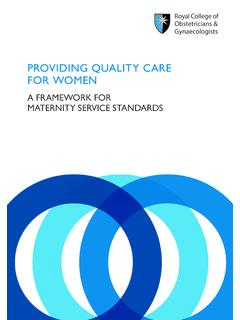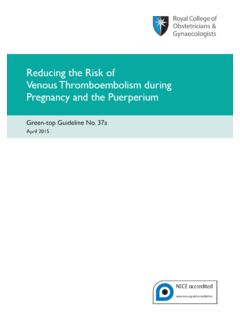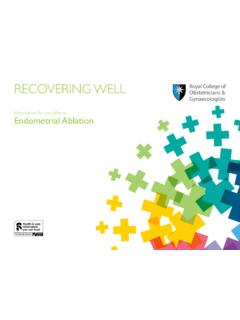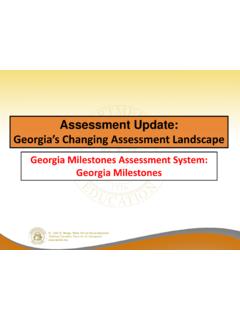Transcription of Green-top Guideline No. 57 - Royal College of ...
1 Reduced Fetal MovementsGreen-top Guideline No. 57 February 2011 Reduced Fetal MovementsThis is the first edition of this Purpose and scopeThe purpose of this Guideline is to provide advice to guide clinicians, based on the best evidence whereavailable, regarding the management of women presenting with reduced fetal movements (RFM) duringpregnancy. This Guideline reviews the risk factors for RFM in pregnancy and factors influencing maternalperception. It provides recommendations as to how women presenting in both the community andhospital settings should be managed. This Guideline excludes the management of RFM in multiplepregnancy. As is apparent from the low grading of the evidence for many of the recommendations, theyhave been developed to provide a broad practical guide for midwives and obstetricians in clinical , it is recognised that in individual women alternative approaches may be Population and settingPregnant women in community or hospital settings reporting RFM in singleton pregnancies.
2 Interventions to be studiedComparison of modalities to detect and manage women perceiving BackgroundMaternal perception of fetal movement is one of the first signs of fetal life and is regarded as a manifes-tation of fetal ,2 Movements are first perceived by the mother between 18 and 20 weeks ofgestation and rapidly acquire a regular pattern. Fetal movements have been defined as any discrete kick,flutter, swish or significant reduction or sudden alteration in fetal movement is a potentiallyimportant clinical sign. It has been suggested that reduced or absent fetal movements may be a warningsign of impending fetal death. Studies of fetal physiology using ultrasound have demonstrated anassociation between RFM and poor perinatal ,5 The majority of women (55%) experiencing astillbirth perceived a reduction in fetal movements prior to number of studies of fetal deathsin Norway and the UK identified that an inappropriate response by clinicians to maternal perception ofRFM was a common contributory factor in , and assessment of evidenceThis Guideline was developed in accordance with standard methodology for producing RCOG Green-topGuidelines.
3 Medline, Pubmed, all EBM reviews (Cochrane CRCT, Cochrane Database of Systematic Reviews,Methodology register, ACP journal club, DARE, HTA, Maternity and Infant Care), EMBASE and TRIP weresearched for relevant randomised controlled trials, systematic reviews and meta-analyses, cohort studiesand case studies. The search was restricted to articles published between 1980 and November 2008. Searchwords included fetal activity , fetal movement + detection , reduced fetal movement , fetal cardio -tocography , fetal heart auscultation and umbilical artery Doppler , including all relevant MeSH terms. Thesearch was limited to humans and the English language. The National Library for Health and the NationalGuidelines Clearing House were also searched for relevant guidelines. Where possible, recommendationsare based on available evidence;areas where evidence is lacking are annotated as good practice points(designated by a tick).
4 Limitations of data used in this guidelineInterpreting studies of women perceiving RFM is complicated by multiple definitions of normal andabnormal fetal movements (discussed in detail in section 5 of this Guideline ) and a paucity of large-scaleRCOG Green-top Guideline No. 572of 16 Royal College of Obstetricians and Gynaecologists(over 1000 participants) descriptive or intervention studies. There are no randomised controlled trialsaddressing the management of RFM. The main outcome of interest stillbirth is relatively uncommon andadequately powered studies of different management protocols would require large numbers of parti c-ipants. Consequently, many studies have limitations in terms of definition of RFM and outcomes,ascertain ment bias and selection bias. are considered normal fetal movements during pregnancy?
5 Most women are aware of fetal movements by 20 weeks of gestation. Clinicians should be aware (and should advise women) that although fetal movements tend to plateauat 32 weeks of gestation, there is no reduction in the frequency of fetal movements in the late thirdtrimester. Perceived fetal movements are defined as the maternal sensation of any discrete kick, flutter, swish or fetal activity provides an indication of the integrity of the central nervous and musculoskeletalsystems. The normal fetus is active and capable of physical movement,and goes through periods of bothrest and sleep. The majority of women perceive fetal movements and intuitively view their experience offetal activity as normal. From 18 20 weeks of gestation,most pregnant women become aware of fetal activity,althoughsome multiparous women may perceive fetal movements as early as 16 weeks of gestation andsome primiparous women may perceive movement much later than 20 weeks of number of spontaneous movements tends to increase until the 32nd week of 11 From this stage of gestation, the frequency of fetal movements plateaus until the onset oflabour;however,the type of fetal movement may change as pregnancy advances in the 13By term, the average number of generalised movements per hour is 31 (range 16 45),with the longest period between movements ranging from 50 to 75 minutes.
6 Changes in thenumber and nature of fetal movements as the fetus matures are considered to be a reflectionof the normal neurological development of the fetus. From as early as 20 weeks of gestation, fetalmovements show diurnal changes. The afternoon and evening periods are periods of ,15 Fetal movements are usually absent during fetal sleep cycles,which occur regularlythroughout the day and night and usually last for 20 40 ,16 These sleep cycles rarelyexceed 90 minutes in the normal, healthy 18 Because of the paucity of robust epidemiological studies on fetal activity patterns and maternal perceptionof fetal activity in normal pregnancies,there is currently no universally agreed definition of RFM. there factors which influence a woman s perception of this activity? Women should be advised of the need to be aware of fetal movements up to and including the onset oflabour and should report any decrease or cessation of fetal movements to their maternity unit.
7 Fetal activity is influenced by a wide variety of factors. There is some evidence that women perceive mostfetal movements when lying down, fewer when sitting and fewest while is therefore notsurprising that pregnant women who are busy and not concentrating on fetal activity often report a misper-ception of a reduction of fetal ,17 Johnson demonstrated that when attention is paid to fetalactivity in a quiet room and careful recordings are made, fetal movements that were not previouslyperceived are often recognised ,20 Prior to 28+0weeks of gestation, an anteriorly positioned placenta may decrease a woman sperception of fetal Royal College of Obstetricians and Gynaecologists3of 16 RCOG Green-top Guideline No. 57 CBEvidencelevel 2 PEvidencelevel 2 Sedating drugs which cross the placenta such as alcohol, benzodiazepines, methadone and otheropioids can have a transient effect on fetal ,23 Several observational studies have demonstrated an increase in fetal movements following the elevationof glucose concentration in maternal blood, although other studies refute these ,25 From 30weeks of gestation onwards, the level of carbon dioxide in maternal blood influences fetal respiratorymovements, and some authors report that cigarette smoking is associated with a decrease in ,26,27 The administration of corticosteroids to enhance fetal lung maturation has been reported bysome authors to decrease fetal movements and fetal heart rate variability detected bycardiotocography (CTG)
8 Over the 2 days following 30 The pathophysiology ofcorticosteroid changes in fetal movement and fetal heart rate variability is still unclear and hasnot been definitely 31 Evidence level 2-Fetuses with major malformations are generally more likely to demonstrate reduced fetal , normal or excessive fetal activity has been reported in anencephalic ,33A lack of vigorousmotion may relate to abnormalities of the central nervous system, muscular dysfunction or presentation has no effect on perception of position might influence maternal perception:80% of fetal spines lay anteriorly in womenwho were unable to perceive fetal movements despite being able to visualise them when anultrasound scan was can fetal movements be assessed?Fetal movements should be assessed by subjective maternal perception of fetal movements.
9 Fetal movements are most commonly assessed by maternal perception alone. Studies on thecorrelation between maternal perception of fetal movements and fetal movements concurrentlydetected on ultrasound scans show wide variation, with correlation ranging from 37 to 88%and large body movements and those lasting more than 7 seconds most likely to be 43 Thegreatest number of fetal movements are noted when the mother is lying down,and the numberappears to be greatest in the may be an effect of concentrating on fetalmovements. The difference in mean time to perceive 10 movements varied between 21 minutesfor focused counting to 162 minutes with unfocused perception of fetal ,17 Objective assessments of fetal movements use Doppler or real-time ultrasound to detect fetalmovement. These studies report slightly increased sensitivity for fetal movements recorded byultrasound,with of all movements recorded compared with for maternallyperceived fetal ,45 However, the duration of recording is restricted to 20 30minutes with the mother in a semi-recumbent position.
10 There are no studies which haveevaluated the use of longer periods of fetal movement counting by Doppler ultrasound orwhether this method can detect fetuses at risk of stillbirth. Given the potential detection offalse-positive signals from maternal abdominal wall movements such as coughing, this may notbe a useful means to objectively measure fetal movements in all pregnant Green-top Guideline No. 574of 16 Royal College of Obstetricians and GynaecologistsEvidencelevel 3 Evidencelevel 2 Evidencelevel 2+Evidencelevel 2 CEvidencelevel 2 Evidencelevel 2 7. Should fetal movements be counted routinely in a formal manner?There is insufficient evidence to recommend formal fetal movement counting using specified alarm limits. Women should be advised to be aware of their baby s individual pattern of movements. If they areconcerned about a reduction in or cessation of fetal movements after 28+0weeks of gestation, they shouldcontact their maternity unit.
